Following Uncle Barry’s Footsteps by Stephen Pegrum
Following Uncle Barry’s Footsteps
During the winter of 2018/19 I suggested to my brother and sister that it would be timely to show our respects to our Uncle (service no. 14612177) on the 75th anniversary of his death by visiting Orvieto War Cemetery, Italy where he is buried. Having visited the cemetery in 1992 with a friend and then in 2017 with my wife and two boys, I was familiar with the site but then my brother James also suggested visiting the area where he died. From that moment onwards started months of research into the WW2 Italian campaign and at times became almost an obsession for me.
My aunt had obtained some information about her brother whilst he was in Italy during 1944 from various sources and these had been passed onto me when she died some years ago. However, when I started to study some of these documents to establish the area where Uncle Barry had died, I quickly realized that there was an error. My Uncle served in 105 Anti-Tank, 315 Battery Royal Artillery and a copy of the War Diary for 105th AT Regiment records that on the 24t June 1944 “All three troops engaged in supporting infantry making crossing of stream N of Pescia. One M10 knocked out by bazooka fire – 4 killed, 1 wounded. 1 other man wounded by shrapnel”. A map my Aunt had been given highlighted a place called Pescia West of Florence. However, when looking at the Italian Campaign timeline, it didn’t take long to find out that the Allies where not that far North in late June. Consequently, I started to look at where the front line was around 24th June and discovered that the Germans had formed a defence line known as The Trasimene Line during this period. This defence line was primarily set up to enable the Germans to delay the Allied forces so they could fortify and strengthen the Gothic line further North. Between 20 -29th June 1944, two British Infantry Divisions, the 78th and 4th, fought a hard battle against 1 Fallschirmjager-Division and 334 Infanterie-Division of the German 10th Army in the territory which lies between Lake Trasimeno to the east and the two lakes of Chiusi and Montepulciano to the West hence the name ‘The Trasimeno Line’
Further study then showed that there was a very small hamlet just to the West of Lake Trasimene called Pescia and indeed there was a small steam running East to West just North of this hamlet. My brother and I then started to research this area further and quickly discovered an excellent book written by Janet Kinrade Dethick called “The Trasimene Line June – July 1944” after which I duly bought a copy. This book provided invaluable information on troop movements which then lead to further internet searches regarding units that had fought around the 24th June.
At the same time, I started to research into the 105th Anti-tank regiment and this proved a lot more difficult. Eventually I was able to find out, via extensive internet searching, that the 105 A/T Regt was formed in Dec 1942 from the 84th A/T Regt and was dis-banded in April 1945. I also discovered that when the 95th A/T Regt was broken up (formally B battery of the 73rd), it joined the 105t A/T Regt and became known as 315 battery. 315 battery was a dedicated battery of self-propelled guns, notably the M10.
I then decided to research the M10 in an attempt to learn more about the armoured vehicle my Uncle served in. Some information my Aunt had been given stated that the M10 was a 17 pounder but research quickly showed that there was also a 3” variant with the 17 pounder being a British conversion of the USA lease-and-lend 3” variant. I bought a book titled “M10 and M36 Tank Destroyers 1942-54” by S J Zaloga and this revealed that the conversions [to 17 pounders] began in spring 1944 and by May 1944 a total of 98 had been converted. However, as D-Day was given priority over the Italian campaign, the first M10C’s were not delivered to Italy until August 1944 [after Uncle Barry’s death] and by mid-September these only totaled 30 in service. I then wrote to the Royal Artillery Museum for clarification and received confirmation that my Uncle had indeed served in a M10 3” ATK SP. As a tank destroyer is was designed as a light and mobile artillery platform but sadly the book also revealed the short-comings of the 3” M10 such as an open turret, inferior gun caliber to the German Panther and Tiger tanks, poor turret traversing time, a rear facing machine gun, relatively thin armour, and narrow tracks that resulted in the vehicles becoming bogged down when it was muddy. Despite these shortcomings the M10 was produced in great numbers and proved to be a very valuable and versatile vehicle in the battlefield. During the battle for the Trasimene line, the M10’s were deployed with infantry divisions to provide fire support as well as indirect fire support for field artillery rather than as a dedicated tank destroyer and consequently their shortcomings were exposed.
Having a crew of five, the War Forces Records for my Uncle revealed that he was a ‘Driver Operator’. The Orvieto War Cemetery listing showed three other men from the same regiment had died on the same day as our Uncle and in the aftermath of battle it seems plausible that casualties would have been buried together and therefore almost certain that these men were in the same M10 as my Uncle. The names of these soldiers are Harry Turner (1094342 Acting Lance Bombardier), Evan George Hopkins (14331357 gunner) and Harold Taylor (5126016 gunner). I then started an attempt to find the details of the wounded crew member and research indicated that most of 78 Division’s casualties were taken to Orvieto field hospital. For those that subsequently died in the hospital, Bolsena was the cemetery where they were buried. Studying records of Bolsena cemetery showed that there was a sole gunner buried there from 105 AT Regiment. His recorded date of death is 25th June 1944 and he was born in Hampshire with the name Arthur Grantham (886462). Based on this evidence it seems plausible that Arthur was the 5th crew member of Uncle Barry’s M10.
My attention then focused on the War Diary record statement that the M10 was “knocked out by Bazooka fire”. The Germans infantry used two types of hand-held anti-tank weapons, the Panzershreck (classified as a bazooka) which was the larger of the two and the Panzerfaust which, although smaller and cruder, could still penetrate up to 5½ inches of plain steel at a range of 60 feet. No conclusion can be made as to which weapon was used but based on the fact the Panzerfaust was considerably more common amongst infantry divisions it’s more likely to have been that weapon.
Moving on to the events of the 24th June 1944, the forward Allied forces had pushed the German troops up to the hamlets of Pescia and Ranciano and were lined up across Pucciarelli having captured Sanfatucchio after intense fighting. By mid-afternoon both these hamlets had been retaken by the Royal Irish Fusiliers with assistance from C Squadron Ontario tank Regt. 105 AT Regiment had moved up to Sanfatucchio with the Royal Wiltshire Yeomanry early the same morning and had now joined the front line which had halted along the Pescia stream as it was proving impossible to cross with vehicles and armour due to the steep bank wall on the north side of the stream and the partially demolished road bridge about a mile to the east. A bridgehead was made by the 5th Buffs by 19:30 that evening and engineers from 214 Field Company worked all night [24th – 25th] in a heavy thunderstorm to rebuild the bridge. It was during the time from when the hamlets had been retaken and the next day that our Uncle lost his life along with three of the other crew members.
We visited the site of the battle and could easily see why the German Army used the Pescia stream as a natural defence line since the north bank of the stream is over 10 feet high and very steep with the south side being about 6 feet with a very narrow bed, albeit 75 years later. The cornfields within the area where our Uncle died where intermixed with red poppies and the quietness and peace seemed surreal when imagining the events of 75 years ago at the same place.
We fixed a large poppy to a sign post by the side of the road and left each other to our own thoughts of the sacrifice our Uncle and so many others made for our freedom and values that we believe in.
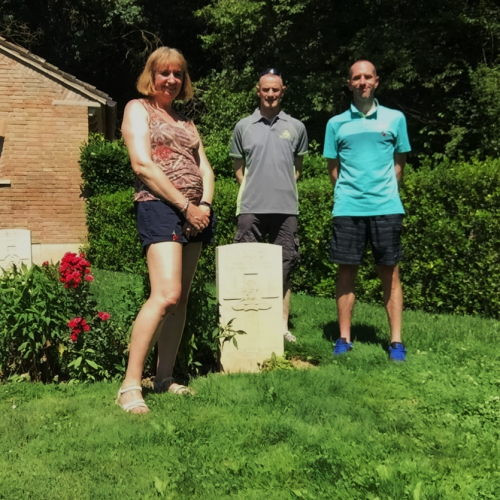
Orvieto War Cemetery lies just off the E35 between Arezzo and Rome and was established as a battlefield cemetery by the 78th Division in the middle of June 1944. There are 190 war graves dating from the period 14th June – 4 July 1944. I must mention how pleased I was to find that our Uncles headstone had been cleaned and the overhanging trees from 2 years ago heavily pruned. The cemetery is a tribute to the continuous hard work carried out by the Commonwealth War Graves Commission.
My brother who is a semi-professional Lego builder honoured our Uncles death by building a diorama and posted a blog which can be found on http://www.bricktothepast.com/blog-to-the-past/the-trasimene-line
We would gratefully welcome any further information/corrections relating to these events around the 24th June 1944 especially with regards to the 105th anti-tank regiment.
Stephen Pegrum

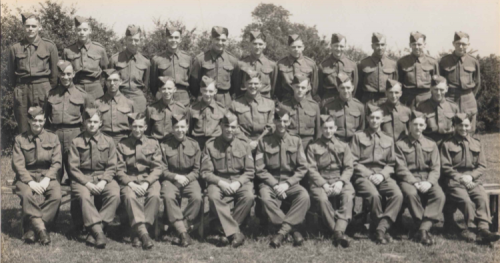
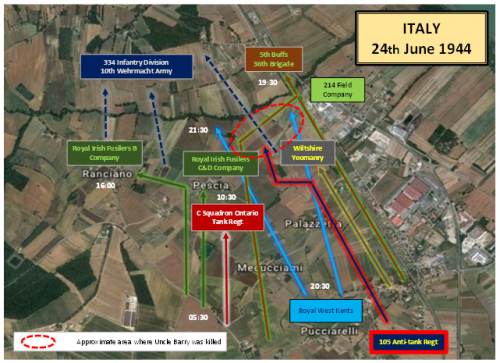
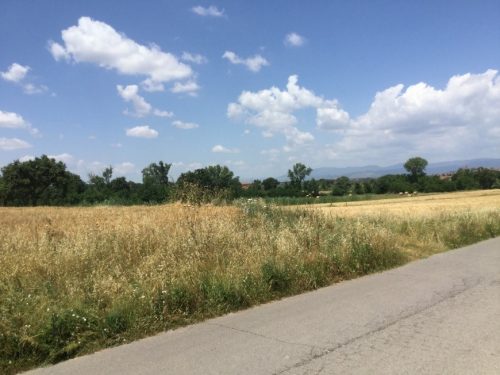
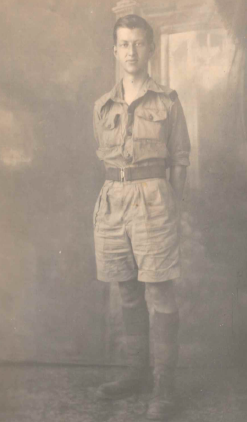
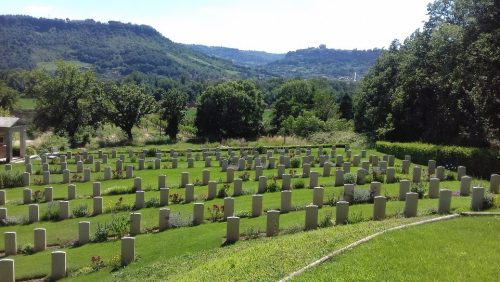
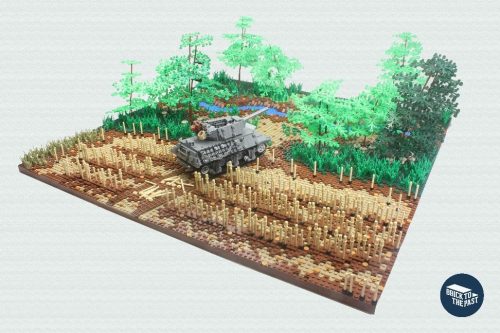
Very interesting thank you. My grandfather also served in the 105th at this time and I am currently researching it. Did you manage to get a copy of the 105th War Diary? I’m slightly frustrated because Kew is closed at the moment.
Hi Richard, yes I have copies of the 105th for mid-June 1944. There is very little information on the 105th from what I can find as the regiment only existed during the war years. It’s listed under 13 Corps and 78th (Battleaxe) Brigade but that’s about it. Interestingly I had someone else also contact me last year after reading the same article and he is also researching the 105th as his great grandfather served in the regiment and was injured in a M10 around the same time my uncle was killed. Do you have any information on your grandfather’s service within the 105th? I would be interested in hearing anything you have because it may add another piece of the regiments jigsaw puzzle.
Hi Stephen,
Thanks for sharing your and your uncles fascinating story.
My Grandfather (William Mulligan) also served in the 105th I am only just starting to look into his service history. Its something he rarely mentioned when he was alive.
I was just wondering where you managed to get hold of the war diary. Was it from the National Archives?
I see they have some sort of collection relating to the 105th but not entirely sure what it is.
Was thinking of a visit but thought it might be worth trying to get as much info on what’s there before I commit to the 300 mile journey.
Anyway thanks again
Kyle
Hi Stephen – thanks for sharing your uncle’s story and for the research. My father (a South African) was a Lt in the 105 and I have a copy of the regimental orders for 1 Dec 1944 (which he typed and signed on behalf of Lt Col SL MacWatt, the Officer Commanding). The orders give a summary of the events leading to the award of the Distinguished Conduct Medal to Sgt DL Lucas for his bravery on 9 July 1944. I realise that this is after your uncle’s death but it does give an insight into the battles that were fought. This is one of the few papers my father kept – he never spoke much of his 5 years in the war). I’d be happy to send you a copy of the orders if you like. My email is justinh.osullivan@gmail.com